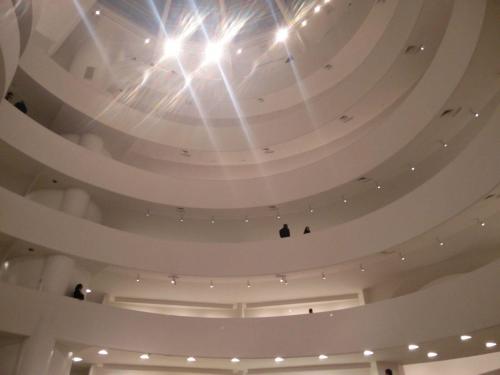Innocence [end]
To walk slowly back out of the spiral toward the shore. In 2018, Kennecott Copper’s parent company, Rio Tinto, began the reclamation process on a section of their property that had been used as a gold mine for thirty years. Workers in bright vests posed for photographs—they were planting trees, remediating soil, altering slope grades, and installing stormwater controls. Company spokesperson Kyle Bennet told the Deseret News, “This is part of what happens with responsible mining companies when you’re no longer actively using areas and you don’t need them anymore. You then reclaim them and make it look more natural… while you’re still mining in other locations. In five or ten years,” he went on, “you’re going to see something that looks much more natural than it does today and it’s going to blend into the hillside.” What he describes is an earthwork to cover an earthwork; another kind of art added to another kind of nature.
Agnes Martin wrote: “My formats are square, but the grids are never absolutely square; they are rectangles, a little bit off square, making a sort of contradiction, a dissonance, though I didn’t set out to do it that way. When I cover the square with rectangles, it lightens the weight of the square, destroys its power.” As we leave her exhibit and Wright’s spiral, I touch my friend Alicia’s arm: “I’m so glad we went. It was so peaceful.”
Lippard: “I’ve come to the reluctant conclusion that much land art is a pseudo rural art made from a metropolitan headquarters, a kind of colonization in itself.” I, too, am reluctant. In destroying the art market, the hierarchy of the clock, Spiral Jetty succeeds and fails. The Jetty, not bounded in time nor space as a saleable artwork, still holds the whiff of the gallery, as if the walls of its white box were stapled over the unruly time-sink of the desert. Smithson acknowledges that “the desert is less ‘nature’ than a concept, a place that swallows up boundaries.” Is the Jetty contextual, anarchic, dissolving all borders? Or is it another mark / market on the so-called “blank” concept of the desert—which, in its colors, fugitivity, fragility, brutality, is anything but blank?
Of course all landscape is an idea. And of course no landscape is an idea. Dia owns the artwork, the state owns the land. Mine, mine. I walk the spiral, insofar as walking is synonymous with thinking. But my thinking doubles back on itself like a line in which every point is visible from every other point.
And yet, it relinquishes control to time; it leaves off.
In an early sketch of the Guggenheim Museum, Frank Lloyd Wright proposed a red exterior, which was never realized.
I move back to Salt Lake City. Soon after arriving, I take a trip to the mine overlook before the gravel road closes for winter. It’s the first time I’ve seen its interior in person since that fourth grade trip. From the overlook I can see the Salt Lake Valley. Turning around, I can see the Tooele Army Depot, legible as a cluster of long white warehouses. Standing, rotating on a single point, I can see: Salt Lake Valley, the Bingham Canyon Mine, the military base. If I turn my head, I don’t even have to move my feet. I can see a grid, then a spiral, then a cluster. Or, in one long sweeping image: gridspiralcluster. Microscopic dump trucks move downward into the pit, the distance imposing a sluggishness to their movements. From this vantage point they look unearthly, like creatures of the underworld forced into service. I stare past them to the grid the spiral made. The bottom of the pit has greyed out, as if mysteriously burned. No bathrooms up here, so I squat down and piss into the gravel. Can they see me from down there? I leave after several minutes with only images, taken on a phone. When I look at them on the drive back, I can’t see the trucks at all. I’m left with empty form: shape, color, and tone, for walking. I put them away; they’re difficult to look at.
More about Lindsey Webb
Lindsey Webb is the author of a chapbook, 'House' (Ghost Proposal, 2020). Her poetry and other writings have appeared in Denver Quarterly, Chicago Review, jubilat, Vestiges, and New Delta Review, among others. She was named a 2021 National Poetry Series finalist. She lives in Salt Lake City, where she is a PhD student in Literature and Creative Writing at the University of Utah.
17 Lee, Jasen. “Rio Tinto Completing the Mining 'Circle of Life'.” Deseret News, 23 Oct. 2018.
18 Dieter Schwartz (ed.), Agnes Martin: Writings. Schriften, Ostfildern-Ruit 1991, p.29
19 Smithson, Robert, and Jack Flam. “‘A Sedimentation of the Mind: Earth Projects (1968).'” Robert Smithson: The Collected Writings, University of California Press, Berkeley, Calif. Etc., 2017, pp. 109.
20 Kimmelman, Micheal. “Frank Lloyd Wright Hated New York, Thought About Making the Guggenheim Pink, and Still Dreamed of Mile-High Skyscrapers.” The New York Times, 8 June 2017.

